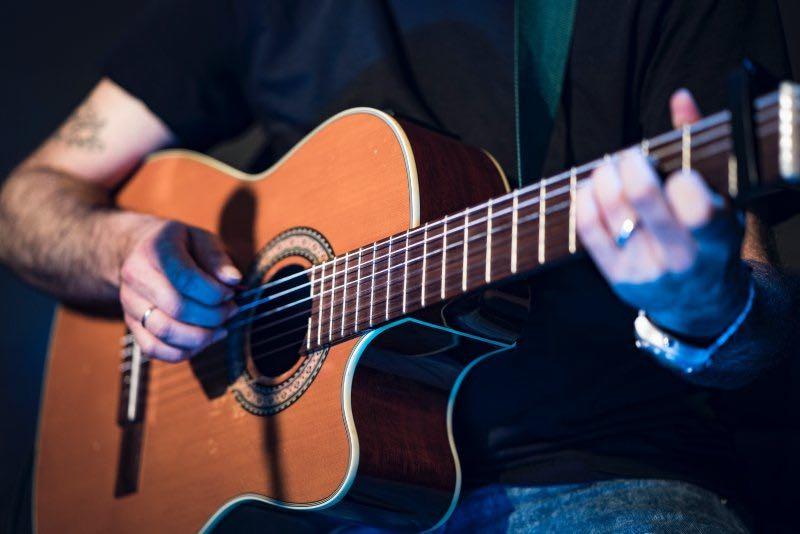What is the goal of music? This may be a question up to interpretation, but I think most people will agree that one possible goal is to play beautifully and tell a story to your audience. If you are like me and you prefer to play classical, fingerstyle, or instrumental styles of guitar, the concept of playing beautifully is incredibly important since we are not singing anything.
So, how can we take standard notes and chords from music and play them to convey a message or story to our audience? Musicality is the concept of using expression and phrasing. How can we do this? In this article, we are going to talk about a few easy concepts you can implement into your guitar playing immediately that will help take your pieces to a new level.
Before we begin, we have to understand what a “gesture” is in music. Musical gesture basically means “what is the mood of this piece and what is its purpose?”. For example, if I see you across the street and smile/wave at you, my gesture is happy. Once you understand the gesture of the piece of music you are learning, you will have a basic idea on how to use the following techniques in this article!
Hand Position
The easiest way to add expression to your music is to play around with your hand position. When we typically play guitar, our picking hand usually falls next to the rosette and soundhole. This position is a nice standard tone when we play the strings. However, if I take my hand position and shift it in either direction, I can get different tones without changing my technique!
Try this with me; take your picking hand and slide it so it is next to the bridge on your guitar. When you play in this location, you will hear your notes sound brighter and tinny; this is called ponticello.
Now, if we take the hand and slide it closer to the fretboard of the guitar, we will get a new tone! In this location, our tone becomes much sweeter and warmer; this is called tasto or dulce (which means sweet in Italian).
As you can see, all we are doing is changing where we strum or pick our notes! Our technique does not change at all! This concept is also known as “color change”.
Dynamics
Dynamics describe how loud or soft we play notes in music. We can easily play dynamics by changing the speed of how we pick or strum! The faster we attack the strings, the louder the notes become. The slower we attack the strings, the quieter the sound becomes. We can also use crescendos and decrescendos, which means we can either gradually get louder or softer in dynamics.
Try this: pick a chord of your choice. Now, pick each string in a row and gradually increase the volume of each string as you pick down. You can also reverse this exercise by starting loud, and then get quieter as you go down each string.
Take a simple melody on the guitar, such as Twinkle Twinkle Little Star, and play around with the dynamics. Swell in volume and see how much more interesting and musical even a simple melody can become!
Articulations
Articulations are described as how notes flow into each other. The two common articulations are staccato and legato. Legato, meaning “to tie together”, is when notes flow smoothly and continuously into each other. Staccato means “to cut off” and refers to stopping a note short. Legato is definitely the more beautiful of the two techniques, but staccato is great for certain sections of music that are more aggressive or tense.
There are also a few other ways we can achieve these effects. Slides, also called glissandos in classical music, are another way of playing legato. We also have the options of rolling chords when we want to accentuate a beautiful chord in whatever piece we’re playing.
Vibrato
One of the goals of playing instrumental or classical guitar is to emulate a human voice. The best guitarists make their music sound voice-like. The most voice-like technique on the guitar is called vibrato, which is where we fret a note and wiggle our wrist side to side. This bends the note out of pitch similar to how a singer’s voice “shakes” when they relax their throat. Adding vibrato on certain notes also helps to sustain the note a bit longer than usual.
The speed of a vibrato can also change the expression of the phrase. Slow vibratos add a lovely wave effect, while a fast vibrato sounds more tense and aggressive. If you really want to sound like a human voice, start the vibrato slow and then gradually increase the speed. The human voice does this naturally, but we have to manually do it as guitarists.
Tips for Musicality
With all of these techniques, you may be asking yourself “Where do I start?”. Here are some tips on how to successfully add these concepts into your music without getting frustrated…
- Sing the melody out loud! Imitate your own voice on the guitar.
- Pick only one concept to start. Sometimes the simplest idea is the best.
- Pick one section of the piece at a time to work on.
- Don’t be afraid to make mistakes.
- Write down the ideas you like on the score with a pencil.
- Don’t overdo phrases! If you use a phrase too much, it becomes predictable.
- Don’t roll every chord! Pick your moments!
Start simple and see where it leads you!
Take an easy piece and start adding one technique at a time. Make mistakes and learn from them! You will find your own unique sound in no time. Good luck!
Want to see/hear these tips in action? Watch this free 25-minute video I made for my former high school students on musicality:
Zach Deyo

